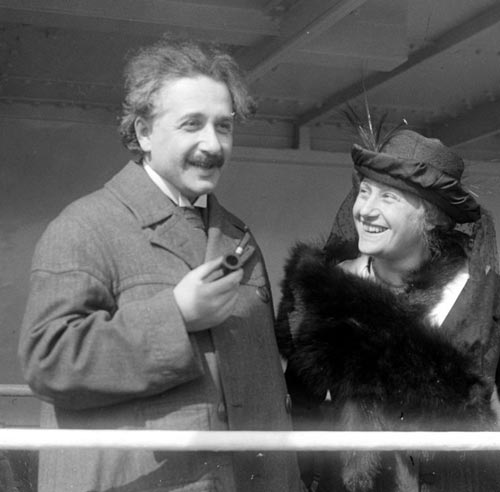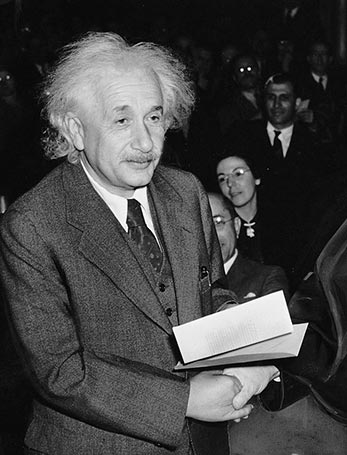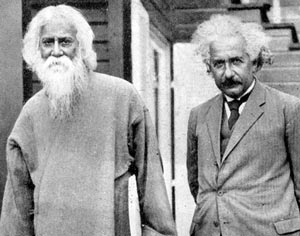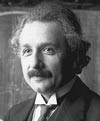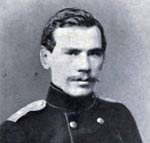биография эйнштейна на английском
Биография Альберта Эйнштейна на английском языке с переводом
Здесь вы можете прочитать биографию Альберта Эйнштейна на английском языке с переводом на русский язык.
Albert Einstein was an outstanding German-born theoretical physicist and one of the fathers of modern physics. He received a Nobel Prize in Physics and was an Honorary Doctor of about 20 leading universities in the world. Einstein wrote more than 300 scientific papers and 150 books on the history and essence of science. He was born on March 14th, 1879, in Ulm, in the family of a salesman. His father and his uncle were the founders of one electrical equipment company. His mother was a housewife. When he was still a toddler, his family moved to Munchen where Albert attended a Catholic elementary school. Later, he transferred to Gymnasium, which now has his name. When he turned 14, he moved to Switzerland, where he studied at the Zurich Polytechnic School. Starting from 1909, he taught at this educational institution and became a Professor.
At the age of 34, he was already the director of the Institute of Physics and a Professor of the University of Berlin. In 1933 he was forced to leave Germany by the Nazis. He moved to the USA then and lectured there at Princeton until his death. His three important scientific works on the theory of relativity, the Brownian motion and quantum theory were published already in 1905. The next year, he created the formula about the relation between mass and energy. In 1916, he predicted the phenomenon of induced radiation of atoms. A year later he completed the general theory of relativity. His theory for the first time in science showed the link between the space-time geometry and distribution of mass in the universe. This theory was based on Newton’s gravitational law. Although Einstein’s theories seemed too revolutionary for that time, it soon received a number of confirmations.
In 1920s and 1930s the anti-Semitism was gradually gaining popularity in Germany. His theory of relativity became a subject of criticism. When the scientific work became impossible in his native country, he moved to the USA. There, he instantly received a professorship at the Princeton Institute for Advanced Study. Unified field theory became the subject of his scientific research for the last twenty years of his life. He tried to bring the theory of gravitation and electromagnetic field together. During the Second World War, he heard of the German uranium project and wrote an open letter to the US President Franklin warning about the possible consequences of the Nazi’s creation of atomic bomb. Shortly before his death, Einstein signed a petition addressed to the governments of all countries, warning them about the dangers of hydrogen bomb and nuclear weapons.
An outstanding and brilliant physicist died on April 18th, 1955. During his life he had a great number of honorary awards and world recognition. He had once received an offer to become the president of Israel, which he politely refused. In 1999, «The Times» magazine named him the man of the century. Einstein was married twice. He met his first wife when he was studying in Zurich. The couple had two sons. In 1919, he got a divorce and married his widowed cousin Elsa, who died in 1936. In his free time he liked playing the violin and was rather good at it. Another cherished hobby of the scientist was sailing.
Перевод:
Альберт Эйнштейн был выдающимся физиком-теоретиком немецкого происхождения и одним из отцов современной физики. Он получил Нобелевскую премию по физике и был почетным доктором около 20 ведущих университетов мира. Эйнштейн написал более 300 научных работ и 150 книг по истории и сущности науки. Родился 14 марта 1879 года в Ульме, в семье продавца. Его отец и дядя были основателями одной электротехнической компании. Его мать была домохозяйкой. Когда он был еще ребенком, его семья переехала в Мюнхен, где Альберт посещал католическую начальную школу. Позже он перевелся в гимназию, которая теперь носит его имя. Когда ему исполнилось 14 лет, он переехал в Швейцарию, где учился в Цюрихской Политехнической школе. С 1909 года преподавал в этом учебном заведении и стал профессором.
В возрасте 34 лет, он уже был директором Института физики и профессор Берлинского университета. В 1933 году нацисты вынудили его покинуть Германию. Затем он переехал в США и читал там лекции в Принстоне до своей смерти. Его три важные научные работы по теории относительности, броуновскому движению и квантовой теории были опубликованы еще в 1905 году. В следующем году он создал формулу о соотношении массы и энергии. В 1916 году он предсказал явление индуцированного излучения атомов. Через год он завершил Общую теорию относительности. Его теория впервые в науке показала связь между пространственно-временной геометрией и распределением массы во Вселенной. Эта теория была основана на законе тяготения Ньютона. Хотя теории Эйнштейна казались для того времени слишком революционными, вскоре они получили ряд подтверждений.
Выдающийся и гениальный физик умер 18 апреля 1955 года. За свою жизнь он имел множество почетных наград и мировое признание. Однажды он получил предложение стать президентом Израиля, от которого вежливо отказался. В 1999 году журнал «The Times» назвал его человеком века. Эйнштейн был дважды женат. Он познакомился со своей первой женой, когда учился в Цюрихе. У супругов было двое сыновей. В 1919 году он развелся и женился на своей овдовевшей кузине Эльзе, которая умерла в 1936 году. В свободное время он любил играть на скрипке и неплохо справлялся. Еще одним заветным увлечением ученого было плавание под парусами.
Albert Einstein Biography
Born in: Ulm, Germany
Famous as: Theoretical Physicist
political ideology: socialist
Spouse/Ex-: Elsa Löwenthal (1919–1936), Mileva Marić (1903–1919)
father: Hermann Einstein
mother: Pauline Einstein
siblings: Maja Einstein
children: Hans Albert Einstein Eduard Einstein, Ilse Einstein, Lieserl Einstein, Margot Einstein
place of death: Plainsboro Township, New Jersey, United States
Notable Alumni: Federal Polytechnic School In Zurich, University Of Zurich
Ancestry: German Americans
Cause of Death: Abdominal Aortic Aneurysm
Founder/Co-Founder: Olympia Academy
discoveries/inventions: Law Of The Photoelectric Effect, Einstein Refrigerator
education: Federal polytechnic school in Zurich, University of Zurich
Recommended For You
Who was Albert Einstein?
Do you fondly call the whiz kid in your class/ organization ‘Einstein’? If yes, then you aren’t the only one who does so. People around the world honor their friends and acquaintance with the title of ‘Einstein’ for the person’s immaculate brilliance and genius mind. While there may be a lot of genius mind set at work to this date, only once in a century is Albert Einstein born. The 19th century not just witnessed the birth of Albert Einstein, but with it, the birth of modern physics. Rightly known as the Father of Modern Physics, Albert Einstein was, without a doubt, the most influential physicist of the 20th century. With his research and finding, Einstein created a revolution in the field of science. Amongst his numerous works: (a) the general theory of relativity, which provided a unified description of gravity as a geometric property of space and time, and (b) photoelectric effect that established the quantum theory within physics are the most important ones. During his lifetime, Einstein published more than 300 scientific papers, apart from 150 non-scientific works. He was the proud recipient of numerous awards, such as Nobel Prize in Physics, Copley Medal, Matteucci Medal and Max Planck medal. Other than these, he has also been credited by the Times magazine as the Person of the Century. Such was his contribution to mankind that his name Einstein has been made synonymous to being «genius».
You wanted to know
What Was Albert Einstein’s IQ?
We all know that Albert Einstein was a genius and his ideas and theories led to several inventions. It is very natural to assume that he must have had a superlative IQ, but we do not have any record to prove that Einstein was ever tested for IQ. As IQ testing was still evolving during Einstein’s emergence as a brilliant physicist, he was never really tested for it. Several attempts have been made to estimate the IQs of long-dead intellectuals and famous people and estimates have been arrived at, but we cannot say with certainty whether these IQ estimates are accurate. Based on Einstein’s choice of research and experiments, it can be assumed that he must have had an extremely high IQ. Some studies put his IQ at 160.
Albert Einstein
Our editors will review what you’ve submitted and determine whether to revise the article.
Albert Einstein was a famous physicist. His research spanned from quantum mechanics to theories about gravity and motion. After publishing some groundbreaking papers, Einstein toured the world and gave speeches about his discoveries. In 1921 he won the Nobel Prize for Physics for his discovery of the photoelectric effect.
Albert Einstein was raised in a secular Jewish family and had one sister, Maja, who was two years younger than him. In 1903 Einstein married Milena Maric, a Serbian physics student whom he had met at school in Zürich. They had three children: a daughter, named Lieserl, and two sons, named Hans and Eduard. After a period of unrest, Einstein and Maric divorced in 1919. Einstein, during his marriage, had begun an affair with his cousin Elsa Löwenthal. They were married in 1919, the same year he divorced Maric.
After suffering an abdominal aortic aneurysm rupture several days before, Albert Einstein died on April 18, 1955, at age 76.
In December 1926 Albert Einstein wrote to Max Born that “[t]he theory produces a good deal but hardly brings us closer to the secret of the Old One. I am at all events convinced that He does not play dice.” Einstein was reacting to Born’s probabilistic interpretation of quantum mechanics and expressing a deterministic view of the world. Learn more.
Albert Einstein, (born March 14, 1879, Ulm, Württemberg, Germany—died April 18, 1955, Princeton, New Jersey, U.S.), German-born physicist who developed the special and general theories of relativity and won the Nobel Prize for Physics in 1921 for his explanation of the photoelectric effect. Einstein is generally considered the most influential physicist of the 20th century.
Childhood and education
Einstein’s parents were secular, middle-class Jews. His father, Hermann Einstein, was originally a featherbed salesman and later ran an electrochemical factory with moderate success. His mother, the former Pauline Koch, ran the family household. He had one sister, Maria (who went by the name Maja), born two years after Albert.
Einstein would write that two “wonders” deeply affected his early years. The first was his encounter with a compass at age five. He was mystified that invisible forces could deflect the needle. This would lead to a lifelong fascination with invisible forces. The second wonder came at age 12 when he discovered a book of geometry, which he devoured, calling it his “sacred little geometry book.”
Einstein became deeply religious at age 12, even composing several songs in praise of God and chanting religious songs on the way to school. This began to change, however, after he read science books that contradicted his religious beliefs. This challenge to established authority left a deep and lasting impression. At the Luitpold Gymnasium, Einstein often felt out of place and victimized by a Prussian-style educational system that seemed to stifle originality and creativity. One teacher even told him that he would never amount to anything.
Yet another important influence on Einstein was a young medical student, Max Talmud (later Max Talmey), who often had dinner at the Einstein home. Talmud became an informal tutor, introducing Einstein to higher mathematics and philosophy. A pivotal turning point occurred when Einstein was 16 years old. Talmud had earlier introduced him to a children’s science series by Aaron Bernstein, Naturwissenschaftliche Volksbucher (1867–68; Popular Books on Physical Science), in which the author imagined riding alongside electricity that was traveling inside a telegraph wire. Einstein then asked himself the question that would dominate his thinking for the next 10 years: What would a light beam look like if you could run alongside it? If light were a wave, then the light beam should appear stationary, like a frozen wave. Even as a child, though, he knew that stationary light waves had never been seen, so there was a paradox. Einstein also wrote his first “scientific paper” at that time (“The Investigation of the State of Aether in Magnetic Fields”).
Einstein’s education was disrupted by his father’s repeated failures at business. In 1894, after his company failed to get an important contract to electrify the city of Munich, Hermann Einstein moved to Milan to work with a relative. Einstein was left at a boardinghouse in Munich and expected to finish his education. Alone, miserable, and repelled by the looming prospect of military duty when he turned 16, Einstein ran away six months later and landed on the doorstep of his surprised parents. His parents realized the enormous problems that he faced as a school dropout and draft dodger with no employable skills. His prospects did not look promising.
Fortunately, Einstein could apply directly to the Eidgenössische Polytechnische Schule (“Swiss Federal Polytechnic School”; in 1911, following expansion in 1909 to full university status, it was renamed the Eidgenössische Technische Hochschule, or “Swiss Federal Institute of Technology”) in Zürich without the equivalent of a high school diploma if he passed its stiff entrance examinations. His marks showed that he excelled in mathematics and physics, but he failed at French, chemistry, and biology. Because of his exceptional math scores, he was allowed into the polytechnic on the condition that he first finish his formal schooling. He went to a special high school run by Jost Winteler in Aarau, Switzerland, and graduated in 1896. He also renounced his German citizenship at that time. (He was stateless until 1901, when he was granted Swiss citizenship.) He became lifelong friends with the Winteler family, with whom he had been boarding. (Winteler’s daughter, Marie, was Einstein’s first love; Einstein’s sister, Maja, would eventually marry Winteler’s son Paul; and his close friend Michele Besso would marry their eldest daughter, Anna.)
Einstein would recall that his years in Zürich were some of the happiest years of his life. He met many students who would become loyal friends, such as Marcel Grossmann, a mathematician, and Besso, with whom he enjoyed lengthy conversations about space and time. He also met his future wife, Mileva Maric, a fellow physics student from Serbia.
Биография Альберта Эйнштейна на английском языке
В этом материале вы можете узнать биографию Эйнштейна с переводом.
Источники информации: страница Википедии и страницы с официального сайта Нобелевской премии (1, 2), где вы можете подробнее почитать про А. Эйнштейна.
 |
 | |||||
 | |||||
 | |||||
 |
 |
 |
 |
 |
 |




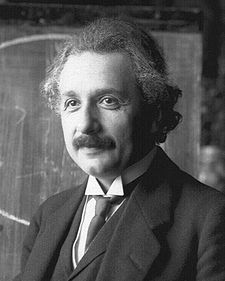 Born in Germany in 1879, Albert Einstein is one of the most celebrated scientists of the Twentieth Century. His theories on relativity laid the framework for a new branch of physics, and Einstein’s E = mc 2 on mass-energy equivalence is one of the most famous formulas in the world. In 1921, he was awarded the Nobel Prize in Physics for his contributions to theoretical physics and the evolution of Quantum Theory.
Born in Germany in 1879, Albert Einstein is one of the most celebrated scientists of the Twentieth Century. His theories on relativity laid the framework for a new branch of physics, and Einstein’s E = mc 2 on mass-energy equivalence is one of the most famous formulas in the world. In 1921, he was awarded the Nobel Prize in Physics for his contributions to theoretical physics and the evolution of Quantum Theory.